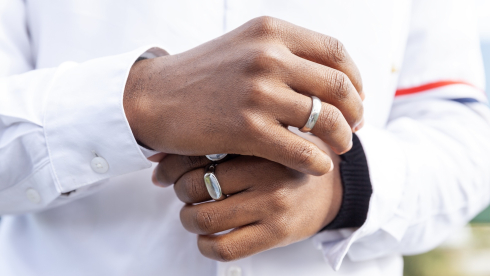Christopher Goins is the founding principal of Butler College Prep, a four-year-old charter high school on the far South Side of Chicago with a student population that is 95 percent low-income and Black.
Much like Goins, who is a bold and snazzy dresser, Butler stands out. Though surrounded by the blighted blocks of the Pullman community, Butler has fast become a model of what urban education should look like, particularly for African-American boys.
“I know Black kids,” Goins said. “I do.”
Last August, Chicago magazine rated Butler the best charter high school in the city. The year before that, the Illinois Network of Charter Schools recognized Noble-Butler as the state’s highest-performing charter school for academic growth among African-American students. Chicago Public Schools (CPS) currently gives Butler the highest rating it can offer, a Level 1+. And though Butler is among 17 other schools in the city run by the Noble Network of Charter Schools, it is arguably the most culturally responsive to its community, as more than half of the staff are people of color.
Goins and I recently sat for a candid conversation specifically about how to best educate African-American boys. And he has some pointed advice for White school leaders—even those within his own Noble Network.
EBONY: What data suggests that the Black boys at Butler are excelling beyond the norm?
Christopher Goins: The number of Black males from CPS and throughout the country that are actually graduating from high school going into college is somewhere around the 20 percent range and the ones that actually graduate from college is maybe like 13 or 14 percent. The fact is that in my senior class—granted it’s only 77 of them—100 percent of those males have been accepted into college and while we don’t know exactly how many of them are going to actually matriculate, you can look at their average ACT score and compare that with the rest of the nation.
EBONY: What is the average ACT score of Butler’s Black male students?
CG: It’s an average of 19.5 for our Black males, but nationally the average is 17 for Black students, both genders. Just the success that we’re seeing on that small scale is important to know.
EBONY: When we talk about charter schools, the question always comes up of how many kids were “counseled out?” How many kids did you lose from freshman year to senior year?
CG: When we started out our freshman year, we had 100 students in our founding class. Now it’s 77. If I look back on it, we did not lose a lot of kids based on “Oh, I just hate this school.” They moved. We’re not having that huge turnover. In four years, that’s roughly 23 kids? That’s pretty decent.
EBONY: Low-income Black students in CPS have the highest mobility rate in the district, so 23 kids over four years is not bad at all. Were any of them expelled?
CG: Of that class? Yes, actually 1…2…3…4 in that class, and [the misbehavior] was egregious.
EBONY: Was it all one incident or separate incidents?
CG: Three of them were from one incident alone. We had reason to believe that they all had a gun in the building. We never found it, but we had enough evidence to show that they brought a gun into the building. They were expelled for that. Then one was for a really egregious fight.
EBONY: How do you balance restorative justice practices with your expulsions?
CG: My dean of discipline, Jasmine Robinson, has become kind of the network’s restorative justice person … expelling a kid is the last resort. We are going to make sure we have all the interventions in place before we get to the point where we have to expel a kid; you have to do something repeatedly and egregiously in order to be expelled.
We try to show folks that we don’t have to be such a punitive, militaristic organization. But I never approached it, Marilyn, like being the militant Black man.
EBONY: Your students took the Adverse Childhood Experiences or ACE survey. How did they score?
CG: Ninety percent of the students who took the ACE survey last year experienced some type of traumatic event. That could have been rape; a parent that was incarcerated; a parent that had died or was murdered; or extreme verbal, physical, or emotional abuse.
We decided not to take the survey this year. We don’t have a full-time social worker anymore, and she had led that effort for the school. We are looking for one.
EBONY: What role does the social worker play when you have a school with stats like that?
CG: It was difficult for her to continue just providing social worker minutes because of the number of crises we had with students. She’s like the first responder to a lot of these things.
EBONY: What is your breakdown demographically of the staffing here, racially and male and female?
CG: Fifty-six staff members: 38 staff members are men and 34 are men of color—over half of the staff are men and men of color. Four of my Black male teachers are members of Profound Gentlemen, a national Black male teacher support organization.
Teachers that are directly in the classroom? Fourteen actual teachers are men of color: 1 Latino, 2 Asian and the rest are Black male teachers.
How is this environment set up to make Black boys successful?
CG: It’s definitely about hiring. It’s definitely about challenging the status quo. That was my goal to recruit and retain more teachers who were men of color. I can relate to them. I’m a part of that struggle. We surround them with so much love and support. The staff buys into that. We don’t do as much time on instruction [in the beginning of the year] because the culture of our school is important to us.
If they don’t love the school and enjoy learning, then they are not going to learn. And it goes back to what research states. Those of us who grew up Black know that we respond to a supportive family-like environment, a place that understands who we are and appreciates who we are.













